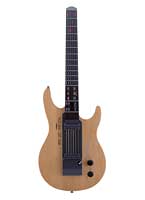|
|
|||||||
|
|
|||||||
|
|||||||
| | Web Japan >> | Trends in Japan >> | Arts & Entertainment >> | Making Music the Easy Way | |
|
MAKING MUSIC THE EASY WAY Budding Musicians Learn Using Simplified Instruments (March 31, 2005) Being a musician can be fun and creatively fulfilling. However, mastering the skills musicians need is a very difficult and time-consuming task. Yet the path to musical proficiency has been considerably shortened in the last few years, thanks to the introduction of a new generation of instruments that make playing music a lot easier than ever before. With many of these hi-tech musical tools, producing sounds that are easy on the ears requires little more than the press of a few buttons. Buttons Light the Way Accompaniments for popular songs are stored electronically inside the body, enabling the guitar to be "played" in time with other instruments. When an accompaniment is selected, the buttons on the neck light up, indicating which chords to play. Yamaha officials claim that even a person with no guitar-playing experience can learn to play hit folk songs on an Easy Guitar with just an hour's practice. Many of the people buying the Easy Guitar are middle-aged, according to the company. Back in the 1970s, when these consumers were young and guitar-based folk and rock music ruled the airwaves, many people took up the guitar. Yet a large proportion of them soon gave up after becoming frustrated while trying to master the fingering techniques for chords, including the notoriously difficult F-major chord. "A lot of these people wanted an easy way to enjoy playing music," a Yamaha representative says, explaining why the Easy Guitar was developed. Toy makers have also come out with user-friendly musical instruments. The We Love Guitar, for example, is made by Takara Co. A company representative explains: "We heard that lots of fatherly types - guys in their 40s and 50s - stop in at music stores at night after finishing work. That's what prompted us to develop this product." Guitars are not the only instruments on offer. With Evio, a violin produced by Tomy, users select prerecorded songs stored inside the instrument. The strings contain sensors, and when a bow is passed over them, the selected song plays in time with the bow's movements. Although Evio was originally aimed at elementary school children, many of the violins have been purchased by adults, according to Tomy officials. Many of these easy-play instruments have the advantage that the volume can be adjusted. Electronic pianos have always had adjustable volumes, but Yamaha has taken this a step further with its Silent Series line, which features a violin, a viola, a cello, a bass, a guitar, and drums. These instruments enable people to play in their bedrooms and apartments without disturbing their neighbors. Music Lessons for Grownups At the 75 Music Salons across Japan run by Shimamura Music, adults take private lessons after work or at other convenient times of their choosing. More than 5,000 people, many of them middle-aged, are learning how to play the piano, violin, saxophone, clarinet, and other musical instruments at this chain of schools. "More than half are at a beginner's level equivalent to when they first learned to play instruments as young children," says a Shimamura representative. These grownup students are apparently eager to learn not just classical and pop music but also the theme music from TV shows. Copyright (c) 2005 Web Japan. Edited by Japan Echo Inc. based on domestic Japanese news sources. Articles presented here are offered for reference purposes and do not necessarily represent the policy or views of the Japanese Government. |
AFTER FIVE (March 29, 2004) THE JAPANESE INSTRUMENT REVIVAL (March 28, 2001) RECLAIMING MUSICAL ROOTS (March 5, 1999) |
|
|



